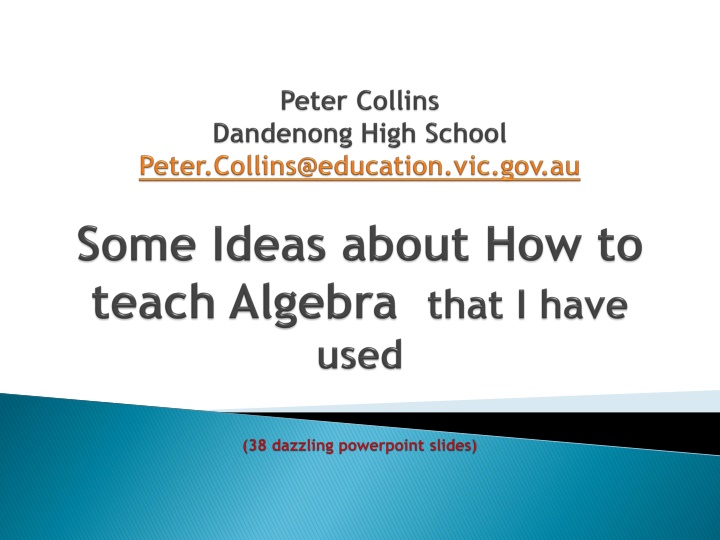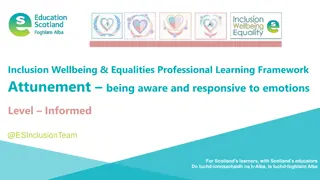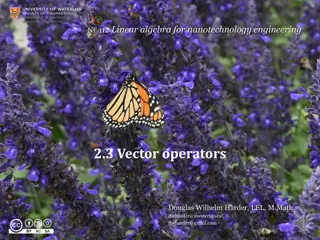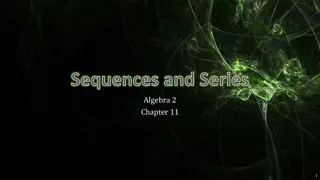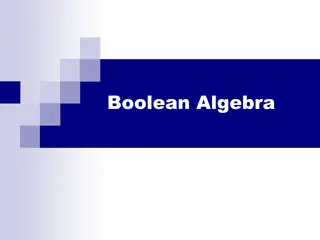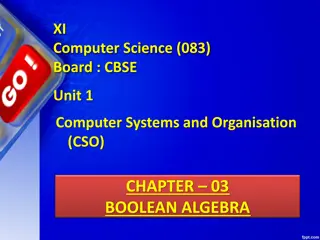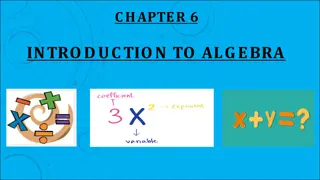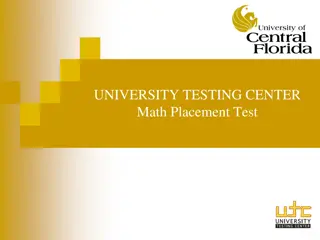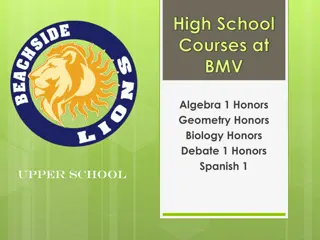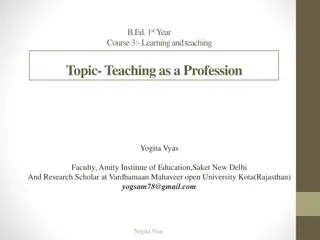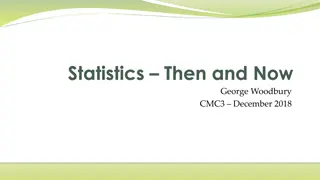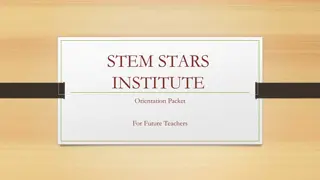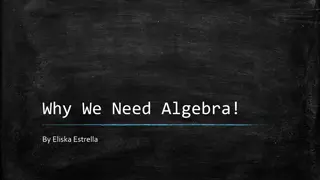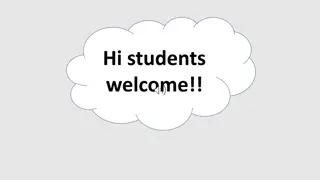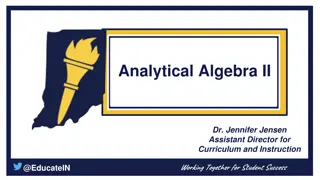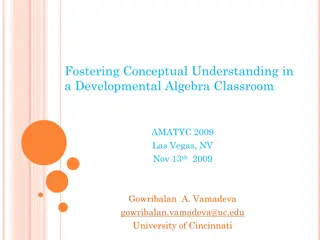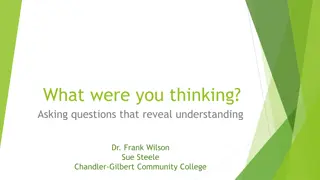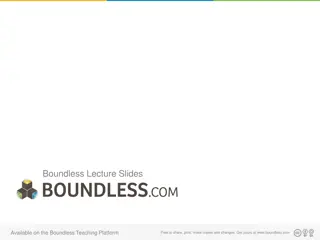Enhancing Algebra Teaching Strategies for Educators
Dive into a comprehensive resource on effective algebra teaching methods, including tips on simplification, substitution, linear equation solving, and more. Discover the importance of proper algebra techniques and how to make the learning process more engaging for students. Explore the evolution of algebra education over the years and learn how to create a cohesive approach to teaching this vital subject.
Uploaded on Sep 13, 2024 | 1 Views
Download Presentation

Please find below an Image/Link to download the presentation.
The content on the website is provided AS IS for your information and personal use only. It may not be sold, licensed, or shared on other websites without obtaining consent from the author.If you encounter any issues during the download, it is possible that the publisher has removed the file from their server.
You are allowed to download the files provided on this website for personal or commercial use, subject to the condition that they are used lawfully. All files are the property of their respective owners.
The content on the website is provided AS IS for your information and personal use only. It may not be sold, licensed, or shared on other websites without obtaining consent from the author.
E N D
Presentation Transcript
38 slides with suggestions on teaching Algebra Some nice pictures Opportunity to ask random questions, some of which may get answered satisfactorily.
1. To save lots of time and writing. Proper algebra is a shortcut / code for stuff that otherwise takes too much time to write out. Because it s tricky, and if you can understand it you are cleverer than people who don t, and because it s important (otherwise it wouldn t be in the book) 2. Hint 2. Is not really valid, although lots of people and traditional teaching techniques act like it is
BIG IDEA Proper algebra is a shortcut / code for stuff that otherwise takes too much time to write out. (You do need to know what the letters stand for.)
In Teachers College (Rusden 1988) I attended a Studies in teaching Maths lecture where they pointed out, using various texts, that Algebra was taught really badly. 1. Looking at today s texts (with associated on line bells and whistles) and data such as Naplan, not a lot has changed. + It is still taught as a disparate list of barely related context free topics, a puddle of random algorithms, rather than a coherent, inter related whole (like a lot of maths) We can do better 2. 3.
Substitution. Simplification to make some substitution easier, show what works and what doesn t Simple linear equation solving, leading on to more complex linear equation solving Other algebra tricks eg expansion Expansion as the opposite of factorisation The null factor law Finding the rule Plotting coordinates Transposing Index laws
Multi step Equation solving Transposing Simple Equation solving Index Laws SUBSTITUTION Find the Rule Simplification Show when simplification works and when it doesn t Expansion Using a rule to fill in an x / y table (and then plotting points on a graph) Factorising Solving using null factor law Algebra mind map
Fill in the table below:- Column 1 ? ?????? ?? ?????? ? ?????? ?? ?????? ? ????? ? ?????? ?? ?????? ? Plus 12 ?????? ?? ?????? ? ??????? By 2 12 20 30 9
Insert letter a with the understanding that it stands for the number in column 1 . Prompt for the rest. Column 1 ? ?????? ?? ?????? ? ?????? ?? ?????? ? ????? ? ?????? ?? ?????? ? Plus 12 ?????? ?? ?????? ? ??????? By 2 ? ? ??? a 3 x a or 3a or a x 3 a - 8 a + 12 ? 12 20 30 9
Students get the idea of algebra saving them time ( I still don t get the a stuff That s OK, write the sentence, either are fine) Can start each lesson with lots of quick questions in a short time handy for starters Can use the same idea to introduce increasingly complex algebra concepts, and show they work with the real numbers they are familiar with. For other substitution, use lots of other examples from other subjects / topics eg ? = ? ? means the same as, but is quicker to write than The Area of a rectangle is equal to the length of the rectangle multiplied by its width
Get students to fill in the table with calculators. B 7B + 3B 21B 19B ??? + ??? ?? 12 20 30 9 Students will find cheat / shortcuts i.e. discover simplification and its purpose i.e. it saves time when the letters are the same (like terms) NOT because 7 bananas + 3 bananas = 10 bananas
a b 2a + 3b 5ab 14a + 7b 12a- 4b ??? 12 3 20 4 7 6 9 2 After doing this, students should see that 2a+ 3b is not equal 5ab or 6ab. i.e. different letters means can t be simplified because the answers are different NOT because you can t add apples to bananas. They will also see that 14a +7b-12a-4b simplifies to 2a + 3b (thus demonstrating simplifying using like terms)
a p 7a + 3p + 3a 2p 10a + p 11ap 12 3 20 4 7 6 9 2 After doing this, students should see that 7a + 3p + 3a 2p simplifies to 10a + p (not one term, but still simpler) (p.s. It is not equal 11ap thus reinforcing previous slide)
If they dont want to simplify when working out tables, fine. (they will just take longer, and their friends will laugh at them) Students who can substitute and know what works, and what doesn t, can then probably do the basic textbook questions Do your multiplication and division simplifications the same way students learn the fact by observing what happens with real numbers and then generalising eg ab = ba, but ? ? ? ?
Practices the real life problem solving approach of looking at a complex problem and seeing when / how it can be made easier and quicker If designing tables to demonstrate it, the more horrible the original expression, combined with the easier the simplified one, the better eg 4.2? + 3.7? + 2.1? Similar tables can be used to demonstrate expansion and then factorisation
a b c a (b + c) ? ? ? + ? ? ? 12 3 11 20 4 1 7 20 3 9 30 2 After doing this, students should see that the two sets of answers are the same. You are still supposed to do the brackets first, but this is an advanced technique for when you don t want to
a b c a (b - c) ? ? ? ? ? ? 17 10 1 23 100 1 7 1000 2 After doing this, students should still see that the two sets of answers are the same, but expanding it is (sometimes) easier than doing the brackets.
Make sure that the letter stands for a number, not a thing eg a = no. of apples, not apples Don t use the letters o, capital I, lower case l, S, lower case b, From year 11 up, avoid e If using z, cross it European style Make sure letter x is written as ? and don t overuse it For novelty purposes I have used Greek and Cyrillic letters it s all good
Like the substitution idea, but in reverse i.e. first find the number you started with to get the answer ? ? ??? a 2 x a or 2a a - 8 a + 12 ? 60 10 20 15 11 This is basic one step linear equation solving (the link with substitution being pretty obvious)
Solve by inspection, or solve by doing opposite functions (if numbers are awkward, maths skills not great) ? + 9 = 23 3? = 21 ? 12 = 24 ? 4 = 9 Plus, see connection between the problems ? + 9 = 23, ? = And +9 = 23 Fill in the box (from primary school) And I think of a number, add 9 and the answer is 23. My number is: - 9 3 +12 4
Solve by doing opposite functions (if numbers are awkward, maths skills not great, decimals or fractions turn up) the skill Identify the opposite function Do whatever it takes, to get one letter by itself on one side of the equation. 2? = 11 ? = 5.5 2
When one step mental arithmetic doesnt work. I like the do the same thing to both sides of the equation idea, until you get the letter by itself eg 2? + 3 = 14 3 2? = 11 2 ? = 5.5 I like the write what you are doing to both sides in the circle, so you keep track of what you are doing
More complex:- 2?+3 4 2?+3 7.5 = 4 +7.5 = 3.5 4 4 2? + 3 = 14 2? = 11 ? = 5.5 3 2 I really like the write what you are doing to both sides in the circle so you keep track
More than one letter? do the same thing to both sides of the equation idea 9? + 3 = 7? + 14 2? + 3 = 14 2? = 11 ? = 5.5 7? 3 2
Brackets? Expand then do the same thing to both sides of the equation idea 3(3? + 1) = 7(? + 2) - Expand 9? + 3 = 7? + 14 2? + 3 = 14 2? = 11 ? = 5.5 7? 3 2
Fractions? Multiply and then do as before 3?+1 7 = 21(3?+1) 7 = 3 3(3? + 1) = 7(? + 2) - Expand 9? + 3 = 7? + 14 2? + 3 = 14 2? = 11 ? = 5.5 ?+2 3 x 21 21(?+2) - Cancel Down 7? 3 2
OR 3?+1 7 3(3?+1) 21 3(3? + 1) = 7(? + 2) - Expand 9? + 3 = 7? + 14 2? + 3 = 14 2? = 11 ? = 5.5 Common denominator = 21 ?+2 3 = = 7(?+2) 21 then 7? 3 2
Some like backtracking using boxes this is fine and the maths is identical Avoid phrases such as Swap to the other side do the opposite they are not that sound and can confuse NB the more complicated sums all simplify down to the easier ones. (All my examples turned to 2a = 11) i.e. later stuff connects obviously to early stuff I like the write what you are doing to both sides in the circle so you keep track approach
Note my examples are interconnected. This is deliberate.
L W A P 10 4 4 36 2 50 2 50 Line 1 is just substitution Line 2 3 solve using A = L x W, then sub to get P Line 4 solve using P = 2L + 2W, then sub to get A
Then demonstrate that if you had many equations to do, transposing might be handy ? = ? ?,? = ? ?,? = ? 2? 2 i.e. Use Equation solving techniques to get transposed equations eg ? both sides etc. Worth reinforcing what those equations mean and that they are quicker than writing the whole thing out
Keep using algebra at all opportunities especially substitution eg When doing measurement write The Area of a rectangle is equal to the length multiplied by the width and A = L x W and tell them to choose whichever one they like. Teach using real numbers first, and then generalise, and show how algebra is a short way of describing the generalisation. (Always welcome to write it in full they won t)
It all starts with substitution Everything else links to it make the links explicit Teach / demonstrate / have them discover using real numbers first, and then generalise, and make clear how algebra is a short way of describing the generalisation. (I do index laws the same way)
Keep attempting to link each new skill to the previous ones, i.e. as variants of existing knowledge rather than a brand new dot point to memorise If you can use the skills in other topics eg whole numbers, do so. If the text starts with simplification rather than substitution, do sub first. Do some simple equation solving at the same time as basic algebra it shows what it is useful for. (Even if it s in a different chapter) The above two points? The book works for you, not vice versa.
